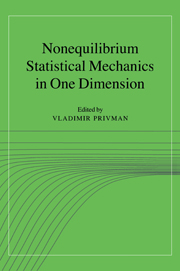Book contents
- Frontmatter
- Contents
- Contributors
- Preface
- Part I Reaction-Diffusion Systems and Models of Catalysis
- Part II Kinetic Ising Models
- Part III Ordering, Coagulation, Phase Separation
- Part IV Random Adsorption and Relaxation Processes
- 10 Random and cooperative sequential adsorption: exactly solvable models on 1D lattices, continuum limits, and 2D extensions
- 11 Lattice models of irreversible adsorption and diffusion
- 12 Deposition-evaporation dynamics: jamming, conservation laws, and dynamical diversity
- Part V Fluctuations in Particle and Surface Systems
- Part VI Diffusion and Transport in One Dimension
- Part VII Experimental Results
- Index
- Abbreviations
12 - Deposition-evaporation dynamics: jamming, conservation laws, and dynamical diversity
Published online by Cambridge University Press: 18 December 2009
- Frontmatter
- Contents
- Contributors
- Preface
- Part I Reaction-Diffusion Systems and Models of Catalysis
- Part II Kinetic Ising Models
- Part III Ordering, Coagulation, Phase Separation
- Part IV Random Adsorption and Relaxation Processes
- 10 Random and cooperative sequential adsorption: exactly solvable models on 1D lattices, continuum limits, and 2D extensions
- 11 Lattice models of irreversible adsorption and diffusion
- 12 Deposition-evaporation dynamics: jamming, conservation laws, and dynamical diversity
- Part V Fluctuations in Particle and Surface Systems
- Part VI Diffusion and Transport in One Dimension
- Part VII Experimental Results
- Index
- Abbreviations
Summary
The dynamics of the deposition and evaporation of k adjacent particles at a time on a linear chain is studied. For the case k = 2 (reconstituting dimers), a mapping to the spin-½ Heisenberg model leads to an exact evaluation of the autocorrelation function C(t). For k ≥ 3, the dynamics is more complex. The phase space decomposes into many dynamically disconnected sectors, the number of sectors growing exponentially with size. Each sector is labeled by an irreducible string (IS), which is obtained from a configuration by a nonlocal deletion algorithm. The IS is shown to be a shorthand way of encoding an infinite number of conserved quantities. The large-t behavior of C(t) is very different from one sector to another. The asymptotic behavior in most sectors can be understood in terms of the diffusive, noncrossing movement of individual elements of the IS. Finally, a number of related models, including several that are many-sector decomposable, are discussed.
Introduction
Problems related to random sequential adsorption (RSA), initially studied several decades ago, have aroused renewed interest over the past few years. The reason for this is the growing realization that the basic process of deposition of extended objects, which is modeled by RSA, has diverse physical applications. In turn, this has led to the examination of a number of extensions, including the effect of interactions between atoms on adjacent sites, and the diffusion and desorption of single atoms.
- Type
- Chapter
- Information
- Nonequilibrium Statistical Mechanics in One Dimension , pp. 247 - 260Publisher: Cambridge University PressPrint publication year: 1997
- 1
- Cited by



